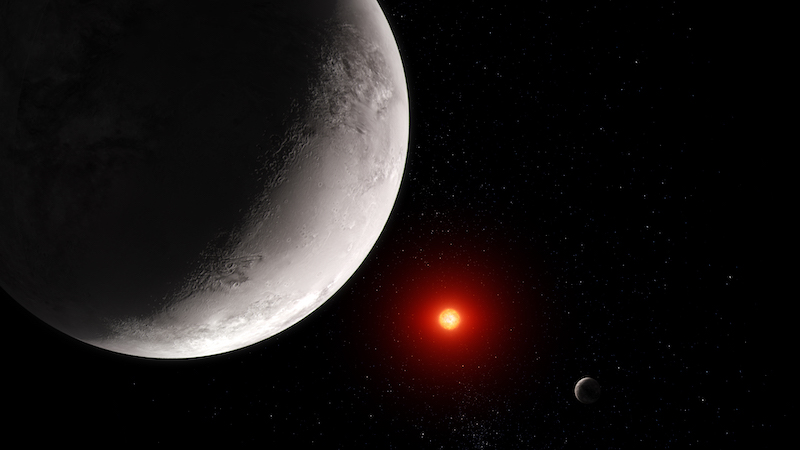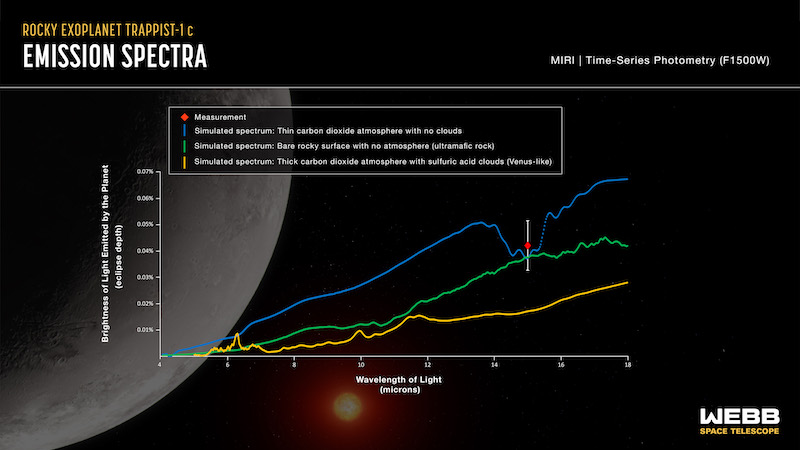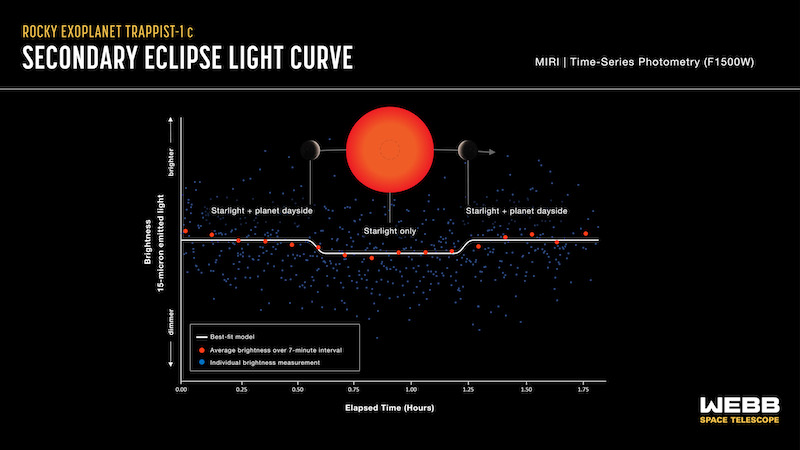
There are 7 Earth-sized exoplanets in the nearby TRAPPIST-1 system, less than 40 light-years away. And astronomers were hoping that this nearby system of worlds would turn out to be a true analog to our own solar system. Looks like it’s not, though. On June 19, 2023, an international group of scientists reported their finding from the Webb space telescope. They said the planet in the Venus-like position in that system – TRAPPIST-1 c – doesn’t have a thick Venus-like carbon dioxide atmosphere, as some astronomers had theorized. But it might still have a very thin atmosphere.
The researchers published their peer-reviewed results in Nature on June 19, 2023.
Astronomers want to know if any rocky planets orbiting red dwarf stars can retain their atmospheres. TRAPPIST-1, 40 light-years away, is a perfect system to study to find out. Lead author Sebastian Zieba, a graduate student at the Max Planck Institute for Astronomy in Germany, stated:
We want to know if rocky planets have atmospheres or not. In the past, we could only really study planets with thick, hydrogen-rich atmospheres. With Webb we can finally start to search for atmospheres dominated by oxygen, nitrogen and carbon dioxide.
Zieba added:
The nearby TRAPPIST-1 planetary system is currently the best candidate to study the atmospheres of rocky, Earth-like planets orbiting a red dwarf star.
NASA tweeted the findings in a thread on June 19:
TRAPPIST-1 b lacked atmosphere. TRAPPIST-1 c? Much the same. Though thought to be similar to Venus (both in size and amounts of radiation from its star), Webb found it lacks Venus’s thick CO2-rich atmosphere. If there is one, it’s very thin. https://t.co/41DctdtCNy pic.twitter.com/fZ0Hh68a99
— NASA Webb Telescope (@NASAWebb) June 19, 2023
Is TRAPPIST-1 c a Venus twin?
TRAPPIST-1 c is almost the same size and mass as Venus. Some astronomers, therefore, surmised that it too might have a thick carbon dioxide atmosphere. But the planet orbits a red dwarf star. Red dwarfs are highly active, emitting intense blasts of radiation. That radiation can strip the atmosphere from any planet that orbits too close to the star. And that’s exactly what appears to have happened with TRAPPIST-1 b, and it may be similar for TRAPPIST-1 c.
Co-author Laura Kreidberg, also from the Max Planck Institute for Astronomy, added:
TRAPPIST-1 c is interesting because it’s basically a Venus twin: It’s about the same size as Venus and receives a similar amount of radiation from its host star as Venus gets from the sun. We thought it could have a thick carbon dioxide atmosphere like Venus.
The results from Webb indicate that the planet does not have a thick atmosphere, so this world is nothing like Venus.

Secondary eclipse provides clues
Webb used its Mid-Infrared Instrument (MIRI) to study TRAPPIST-1 c as it passed behind its star. That phenomenon is called a secondary eclipse. Webb did this four times in total. The astronomers compared the brightness of the star when the planet is behind it (starlight only) to the brightness when the planet is beside the star (light from both the star and planet combined). The researchers measured the amount of mid-infrared light, specifically with a wavelength of 15 microns, coming from the dayside of the planet. Carbon dioxide likes to absorb that 15-micron wavelength of mid-infrared light.
The team focused on the dayside of TRAPPIST-1 c since the planet is thought to be tidally locked. That is, it always keeps the same side facing its star as it orbits.
The amount of infrared light, in turn, provides data about the temperature of the planet. Since carbon dioxide absorbs 15-micron light, the planet will appear dimmer if there is a lot of the gas present. If not, it will appear brighter. One caveat, however, is that clouds will reflect light and could mask the carbon dioxide from detection.
Also, a thick atmosphere would be needed to transfer heat from the dayside of the planet to the nightside. That is due to the planet being tidally locked. That would also lower the overall temperature of TRAPPIST-1 c.
Thin atmosphere possible on TRAPPIST-1 c
As Zieba noted, the results indicate only a very thin atmosphere at best:
Our results are consistent with the planet being a bare rock with no atmosphere, or the planet having a really thin CO2 atmosphere (thinner than on Earth or even Mars) with no clouds. If the planet had a thick CO2 atmosphere, we would have observed a really shallow secondary eclipse, or none at all. This is because the CO2 would be absorbing all of the 15-micron light, so we wouldn’t detect any coming from the planet.
As the Max Planck Institute for Astronomy further explained, a thin atmosphere is indeed still possible on TRAPPIST-1 c:
Planets like TRAPPIST-1 c should possess an atmosphere containing carbon dioxide and water vapor early on in their evolution. Over time, the stellar radiation breaks up the water into hydrogen and oxygen. While the highly volatile hydrogen gradually escapes into open space, the heavier oxygen molecules remain, leading to an oxygen-rich atmosphere with traces of carbon dioxide.
As it turns out for TRAPPIST-1 c, the model reflecting that assumption is consistent with a wide range of oxygen-carbon dioxide mixtures and surface pressures between 1% and 100% of Earth’s sea level values. This result raises the hope for TRAPPIST-1 c and other sufficiently heavy rocky planets around cool low-mass stars to sustain an atmosphere over a significant fraction of the stellar lifetime, as the star TRAPPIST-1 is at least as old as the sun.

Implications for habitability
The results are not encouraging for the potential habitability of TRAPPIST-1 c. The lack of a thicker atmosphere, like on Earth or Venus, may mean that there was little water on the planet to begin with. If – and that’s still a big if – the other planets in the system had a similar origin, then they also may lack significant amounts of water. Even the cooler planets farther from the star.
However, other Earth-based studies have suggested that some of the planets farther out should have water, maybe even a lot of it. So for now, the jury is still out until Webb can look at these planets in more detail.
Ultimately, it may indeed turn out that the TRAPPIST-1 system has little or no habitability potential. But just being able to study such distant rocky worlds is a huge accomplishment, as Kreidberg noted:
It is extraordinary that we can measure this. There have been questions for decades now about whether rocky planets can keep atmospheres. Webb’s ability really brings us into a regime where we can start to compare exoplanet systems to our solar system in a way that we never have before.
Bottom line: New findings from NASA’s Webb Space Telescope show that rocky exoplanet TRAPPIST-1 c is not Venus-like as theorized and only has a very thin atmosphere at best.
Source: No thick carbon dioxide atmosphere on the rocky exoplanet TRAPPIST-1 c











